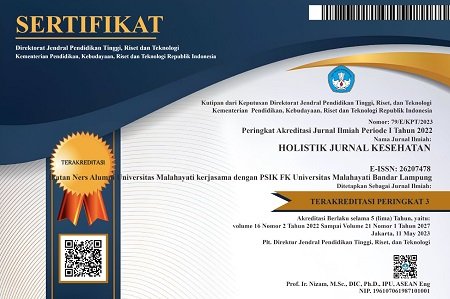Penggunaan perangkat pencitraan fluoresensi bakteri pada luka: A literature review
Abstract
Background: The incidence of chronic infections in wounds of DFU patients is caused by several factors, one of which is the slow diagnosis of diagnosis. The gold standard currently used to identify bacterial infections in wounds is the culture method which takes 2-3 days. FL-Imaging Device is a new technology for detecting bacteria in wounds in a matter of minutes.
Purpose: To determine the effectiveness of using the Bacterial Fluorescence Imaging Device in identifying infectious bacteria in diabetic foot wounds.
Method: The design of this research is a literature review study with reference sources for articles from journals that have been indexed and can be accessed via Sciencedirect, SCOPUS, Clinical Key and EBSCO which were published in the last 5 years (2018-2023). Inclusion criteria are articles that can be accessed in full text, in Indonesian or English and in accordance with the research topic.
Results: Based on the 10 articles reviewed, it is known that the FL-Imanging Device is effective and accurate in detecting infectious bacteria in diabetic foot wounds. It is also known that using the FL-Imanging Device can change treatment plans, reduce the use of AMD, reduce the use of antibiotics, reduce treatment costs and speed up wound healing.
Conclusion: The FL-Imaging Device can help identify the bacterial burden early, monitor the extent to which treatment is effective during and after debridement (wound cleaning), and support reducing antibiotic prescriptions and the use of AMD. With this, it is hoped that it can improve wound healing results.
Keywords: Bacterial Fluorescence Imaging Device; Infection; Wound.
Pendahuluan: Kejadian infeksi kronis pada luka pasien DFU diakibatkan oleh beberapa faktor, salah satunya adalah lambatnya penegakkan diganosa. Standar emas yang saat ini digunakan dalam mengidentifikasi bakteri infeksi pada luka adalah metode kultur yang memakan waktu 2-3 hari. FL-Imaging Device merupakan tekhnologi baru untuk mendeteksi bakteri pada luka dalam hitungan menit.
Tujuan: Untuk mengetahui efektivitas penggunaaan Bacterial Fluorescence Imaging Device dalam mengidentifikasi bakteri infeksi pada luka kaki diabetik.
Metode: Desain penelitian ini adalah studi literature review denan sumber referensi artikel dari jurnal yang telah terindeks dan dapat diakses melalui Sciencedirect, SCOPUS, Clinical Key dan EBSCO yang diterbitkan pada 5 tahun terakhir (2018-2023). Kriteria inklusi artikel yang dapat diaksses secara full text, berbahasa Indonesia atau Inggris dan sesuai dengan topik penelitian.
Hasil: Berdasarkan 10 artikel yang ditelaah, diketahui bahwa FL-Imanging Device efektif serta akurat dalam mendektsi bakteri infeksi yang ada pada luka kaki diabetik. Diketahui juga, bahwa dengan menggunakan bahwa FL-Imanging Device dapat merubah rencana perawatan, mengurangi penggunaan AMD, pengurangi penggunaan antibiotic, mengurangi biata perawatan dan mempercepat penyembuhan luka.
Simpulan: FL-Imaging Device dapat membantu dalam mengidentifikasi beban bakteri secara dini, memantau sejauh mana pengobatan efektif selama dan setelah debridemen (pembersihan luka), serta mendukung untuk mengurangi resep antibiotik dan penggunaan AMD. Dengan tersebut, diharapkan dapat meningkatkan hasil penyembuhan luka.
Keywords
References
Abbade, L. P. F., & Lastória, S. (2006). Management of patients with venous leg ulcer. Anais Brasileiros de Dermatologia, 81, 509-522.
Aji, Z. U. A. P., & Suharyadi, S. (2016). Pemanfaatan Penginderaan Jauh dan Sistem Informasi Geografi dalam Pemetaan Genangan Skala Mikro untuk Kajian Persebaran Leptospirosis di Kecamatan Tembalang, Kota Semarang, Provinsi Jawa Tengah. Jurnal Bumi Indonesia, 5(4), 228810.
Angel, D., Swanson, T., & Sussman, G. (2016). International Wound Infection Institute (IWII). Wound infection in clinical practice. Wounds International.
Armstrong, D. G., Edmonds, M. E., & Serena, T. E. (2023). Point-of-care fluorescence imaging reveals extent of bacterial load in diabetic foot ulcers. International Wound Journal, 20(2), 554–566. https://doi.org/10.1111/iwj.14080
Blackshaw, E. L., & Jeffery, S. L. (2018). Efficacy of an imaging device at identifying the presence of bacteria in wounds at a plastic surgeryoutpatients clinic. Journal of Wound Care, 27(1), 20-26. https://doi.org/10.12968/jowc.2018.27.1.20
Boulton, A. J., Armstrong, D. G., Hardman, M. J., Malone, M., Embil, J. M., Attinger, C. E., & Kirsner, R. S. (2020). Diagnosis and management of diabetic foot infections. https://doi.org/doi:10.2337/ db2020-01
DaCosta, R. S., Kulbatski, I., Lindvere-Teene, L., Starr, D., Blackmore, K., Silver, J. I., & Linden, R. (2015). Point-of-care autofluorescence imaging for real-time sampling and treatment guidance of bioburden in chronic wounds: first-in-human results. Plos one, 10(3), e0116623. https://doi.org/10.1371/journal.pone.0116623
Hurley, C. M., McClusky, P., Sugrue, R. M., Clover, J. A., & Kelly, J. E. (2019). Efficacy of a bacterial fluorescence imaging device in an outpatient wound care clinic: a pilot study. Journal of Wound Care, 28(7), 438-443. https://doi.org/10.12968/jowc.2019.28.7.438
International Diabetes Federation (IDF). (2019). Diabetes ATLAS 9th edition 2019. Diakses dari: https://www.diabetesatlas.org/upload/resour-ces/material/20200302_133351_IDFATLAS9e-final-web.pdf
Khamsah, N. M. N., Utama, S., Surayuda, R. H., & Hakim, P. R. (2019). The development of LAPAN-A3 satellite off-nadir imaging mission. In 2019 IEEE International Conference on Aerospace Electronics and Remote Sensing Technology (ICARES) (pp. 1-6). IEEE.
Le, L., Baer, M., Briggs, P., Bullock, N., Cole, W., DiMarco, D., & Serena, T. E. (2021). Diagnostic accuracy of point-of-care fluorescence imaging for the detection of bacterial burden in wounds: results from the 350-patient fluorescence imaging assessment and guidance trial. Advances in Wound Care, 10(3), 123-136. https://doi.org/10.1089/wound.2020.1272
Parekh, J. N., Soni, P., Meena, M. K., Tandel, C. K., & Radhakrishanan, G. (2022). A New Device and Technology for Detecting Bacterial Infection and its Gram Type in Diabetic Foot Ulcer. Indian Journal of Surgery, 84(5), 990-995. https://doi.org/10.1007/s12262-021-03190-6
Price, N. (2020). Routine fluorescence imaging to detect wound bacteria reduces antibiotic use and antimicrobial dressing expenditure while improving healing rates: Retrospective analysis of 229foot ulcers. Diagnostics, 10(11), 927. https://doi.org/10.3390/diagnostics10110927
Rahayu, T. (2012). Penatalaksanaan luka bakar (combustio). Profesi: Media Publikasi Penelitian, 8, 161583.
Raizman, R., Dunham, D., Lindvere-Teene, L., Jones, L. M., Tapang, K., Linden, R., & Rennie, M. Y. (2019). Use of a bacterial fluorescence imaging device: wound measurement, bacterial detection and targeted debridement. Journal of Wound Care, 28(12), 824-834. https://doi.org/10.12968/jowc.2019.28.12.824
Ruswanto, B. (2010). Analisis spasial sebaran kasus tuberkulosis paru ditinjau dari faktor lingkungan dalam dan luar rumah di Kabupaten Pekalongan (Doctoral dissertation, Universitas Diponegoro).
Sandy‐Hodgetts, K., Andersen, C. A., Al‐Jalodi, O., Serena, L., Teimouri, C., & Serena, T. E. (2022). Uncovering the high prevalence of bacterial burden in surgical site wounds with point‐of‐care fluorescence imaging. International Wound Journal, 19(6), 1438-1448. https://doi.org/10.1111/iwj.13737
Serena, T. E., Harrell, K., Serena, L., & Yaakov, R. A. (2019). Real-time bacterial fluorescence imaging accurately identifies wounds with moderate-to-heavy bacterial burden. journal of wound care, 28(6), 346-357. https://doi.org/10.12968/jowc.2019.28.6.346
Shah, B. M., Ganvir, D., Sharma, Y. K., Mirza, S. B., Misra, R. N., Kothari, P., & Gupta, A. (2022). Utility of a real-time fluorescence imaging device in guiding antibiotic treatment in superficial skin infections. Indian Journal of Dermatology, Venereology and Leprology, 88(4), 509-514. https://doi.org/10.25259/IJDVL_856_1
Viswanathan, V., Govindan, S., Selvaraj, B., Rupert, S., & Kumar, R. (2021). A Clinical Study to Evaluate Autofluorescence Imaging of Diabetic Foot Ulcers Using a Novel Artificial Intelligence Enabled Noninvasive Device. The International Journal of Lower Extremity Wounds, 15347346211047098. https://doi.org/10.117
Wibowo, A. P. W. (2017). Penerapan Teknik Computer Vision Pada Bidang Fitopatologi Untuk Diteksi Penyakit dan Hama Tanaman Cabai. Jurnal Informatika: Jurnal Pengembangan IT, 2(2), 102-108.
DOI: https://doi.org/10.33024/hjk.v17i8.13026
Refbacks
- There are currently no refbacks.
Copyright (c) 2023 Holistik Jurnal Kesehatan

This work is licensed under a Creative Commons Attribution-NonCommercial 4.0 International License.














